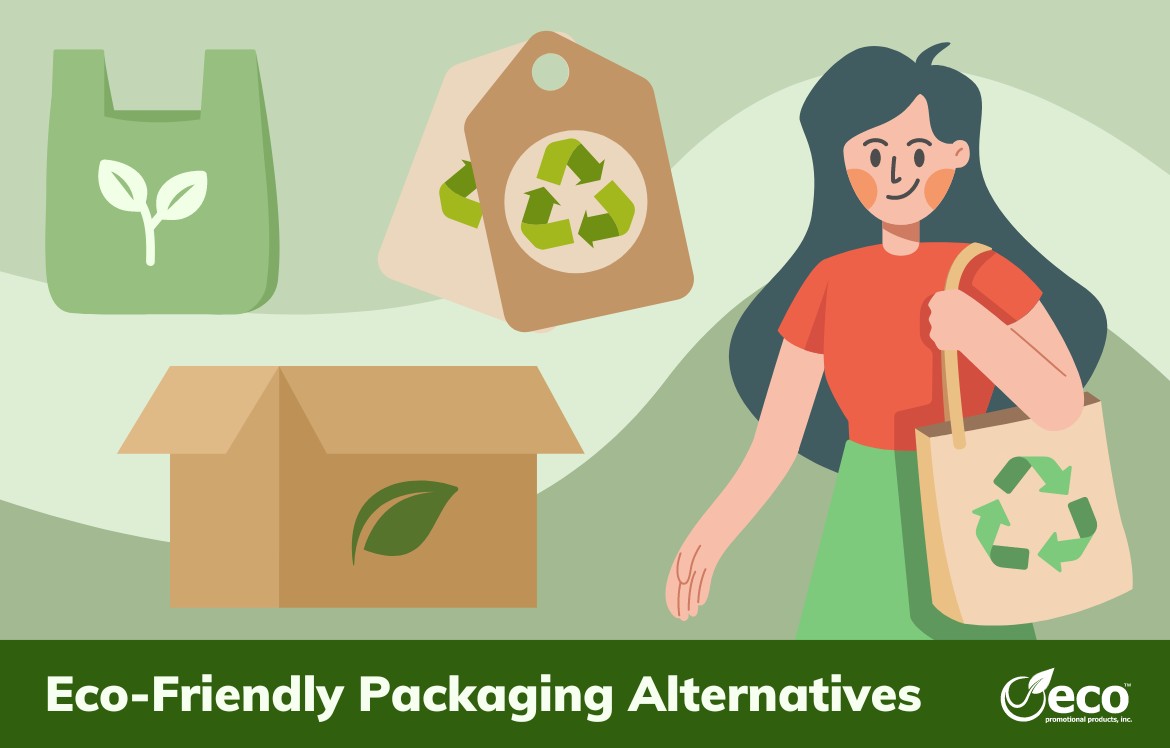Top 6 Eco-Friendly Packaging Alternatives for Businesses
In today's market, eco-friendly packaging is essential. Businesses recognize the need to reduce their environmental footprint and adopt sustainable practices.
Eco-friendly packaging offers a powerful way to achieve this, demonstrating a commitment to environmental stewardship while meeting consumer demand for greener products.
Traditional packaging materials, like plastic, significantly contribute to pollution and waste, often ending up in landfills or oceans and taking centuries to decompose.
Their production and disposal consume vast energy and resources, exacerbating climate change.
This resource page guides businesses in selecting top eco-friendly packaging alternatives, understanding their benefits, and implementing sustainable practices to meet operational and environmental goals.
The Importance of Eco-Friendly Packaging
According to the Mississippi River Plastic Pollution Initiative, the Mississippi River, which drains 40% of the continental United States, acts as a major pathway for litter to travel to the Gulf of Mexico and the ocean. The data reveals that over 74% of the litter documented at pilot sites along the river consists of plastic.
Plastic waste persists in the environment for hundreds of years, no matter if it ends up in rivers, oceans, or on land.
Since packaging will continue to be essential until innovative solutions are developed, it is important to reduce its environmental impact today—rather than later.
According to Kate Daly, the Managing Director of the Center for the Circular Economy at Closed Loop Partners ...
”We’re seeing a tremendous acceleration in the demand for packaging alternatives as the unintended consequences of plastics become more visible, both locally and globally”
Sustainability aligns with the principle of "reduce, reuse, recycle," which can be adopted through various strategies:
- Reduce: Use fewer raw materials in production and process products more sustainably to consume less energy.
- Reuse: Design products for multiple uses, such as reusable car parts packaging or supermarket containers.
- Recycle: Incorporate recycled materials like paper or metal into production and design products to be recyclable into other products, such as making them out of paper.
Eco-friendly packaging reduces its environmental footprint by using recyclable materials that can be broken down naturally, and come from sustainable sources.
The production of eco-friendly packaging also typically requires less energy and resources, which lowers carbon emissions and helps combat climate change.
Additionally, adopting eco-friendly packaging helps companies stay ahead of increasingly strict regulations on packaging waste, avoiding potential fines and ensuring compliance.
Six Eco-Conscious Packaging Strategies for Modern Businesses
1 - Recycled Paper and Cardboard
Recycled paper and cardboard are made from post-consumer waste, reducing the need for virgin materials and conserving natural resources.
According to the EPA, in 2018, paper and paperboard accounted for 23.1% of municipal solid waste (MSW) generated in the U.S., with 68.2% of this amount being recycled.
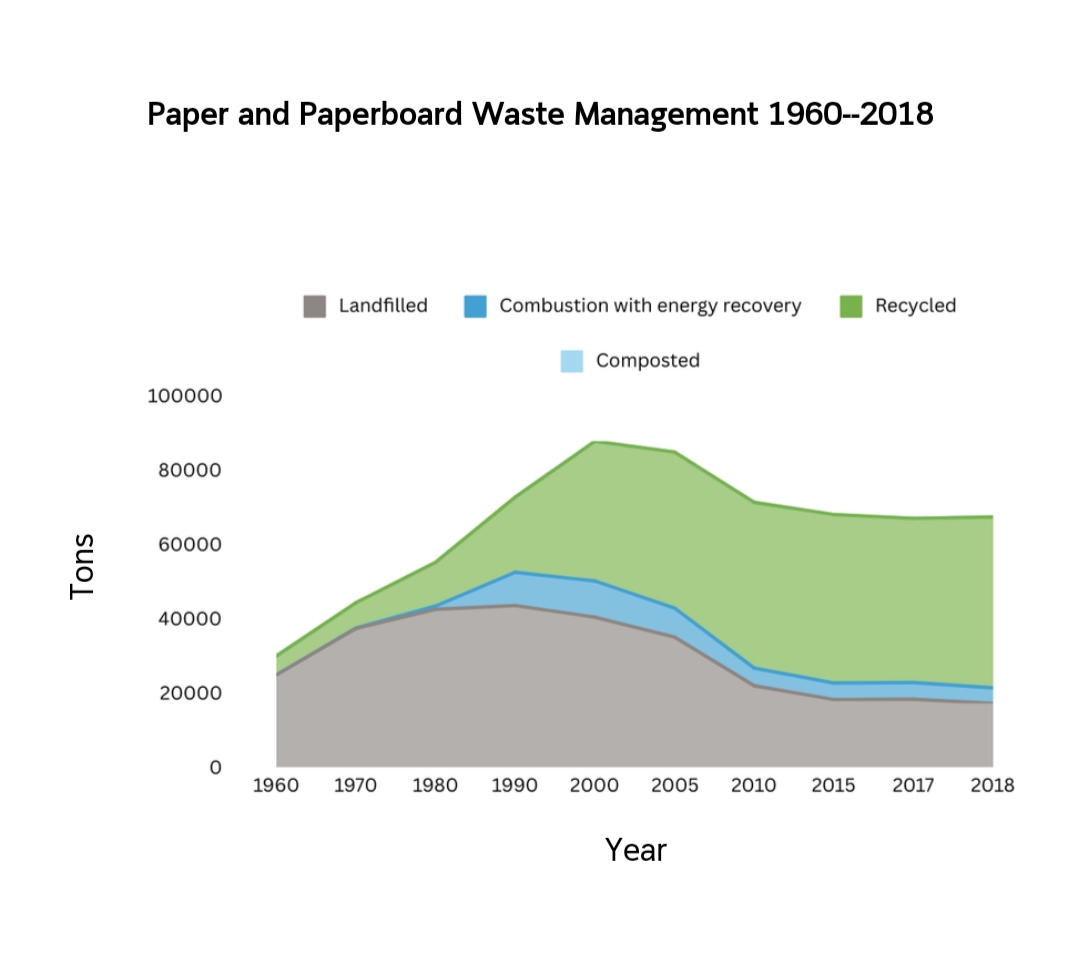
This high recycling rate significantly reduces landfill use and conserves energy and resources.
Additionally, they can be recycled multiple times, extending their lifecycle and reducing waste. This helps businesses lower their carbon footprint and align with sustainability goals.
Implementing recycled paper and cardboard in your packaging strategy can be straightforward:
- Evaluate Packaging Needs: Determine where recycled materials can replace conventional ones, such as shipping boxes, product packaging, and labels.
- Source Responsibly: Look for suppliers that offer certified recycled paper and cardboard products. The American Forest & Paper Association (AF&PA) provides resources to find reputable suppliers.
- Design for Recyclability: Ensure your packaging allows easy recycling by avoiding excessive inks or non-recyclable adhesives and coatings.
- Educate Consumers: Inform your customers about the eco-friendly nature of your packaging and how they can recycle it.
Recycled paper and cardboard are versatile and can be used for a variety of packaging needs, for example:
- Shipping boxes: Durable and sturdy, ideal for transporting goods.
- Product packaging: Suitable for wrapping, cushioning, and presenting products.
- Labels and tags: These can be used for branding and product information.
Switching to recycled paper and cardboard shows businesses' commitment to sustainability and lowers their carbon footprint.
2 - Biodegradable Plastics
Biodegradable plastics from corn starch and sugarcane break down naturally, reducing landfill waste and ocean pollution.
A recent study from the University of California, Berkeley, published on April 21, 2021, highlights a groundbreaking process where biodegradable plastics are embedded with enzymes.
These enzymes, activated by specific conditions such as heat and moisture, break the plastic into recyclable small molecules, ensuring complete decomposition.
This innovation addresses a critical challenge in biodegradable plastics, ensuring they do not leave harmful microplastics behind.
”We are saying that we are on the right track. We can solve this continuing problem of single-use plastics not being biodegradable.”
—Ting Xu, UC Berkeley Professor of Materials Science and Engineering and of Chemistry
According to European Bioplastics, the bioplastics market is rapidly expanding, with production capacities expected to grow from 2.18 million tonnes in 2023 to approximately 7.43 million tonnes by 2028.
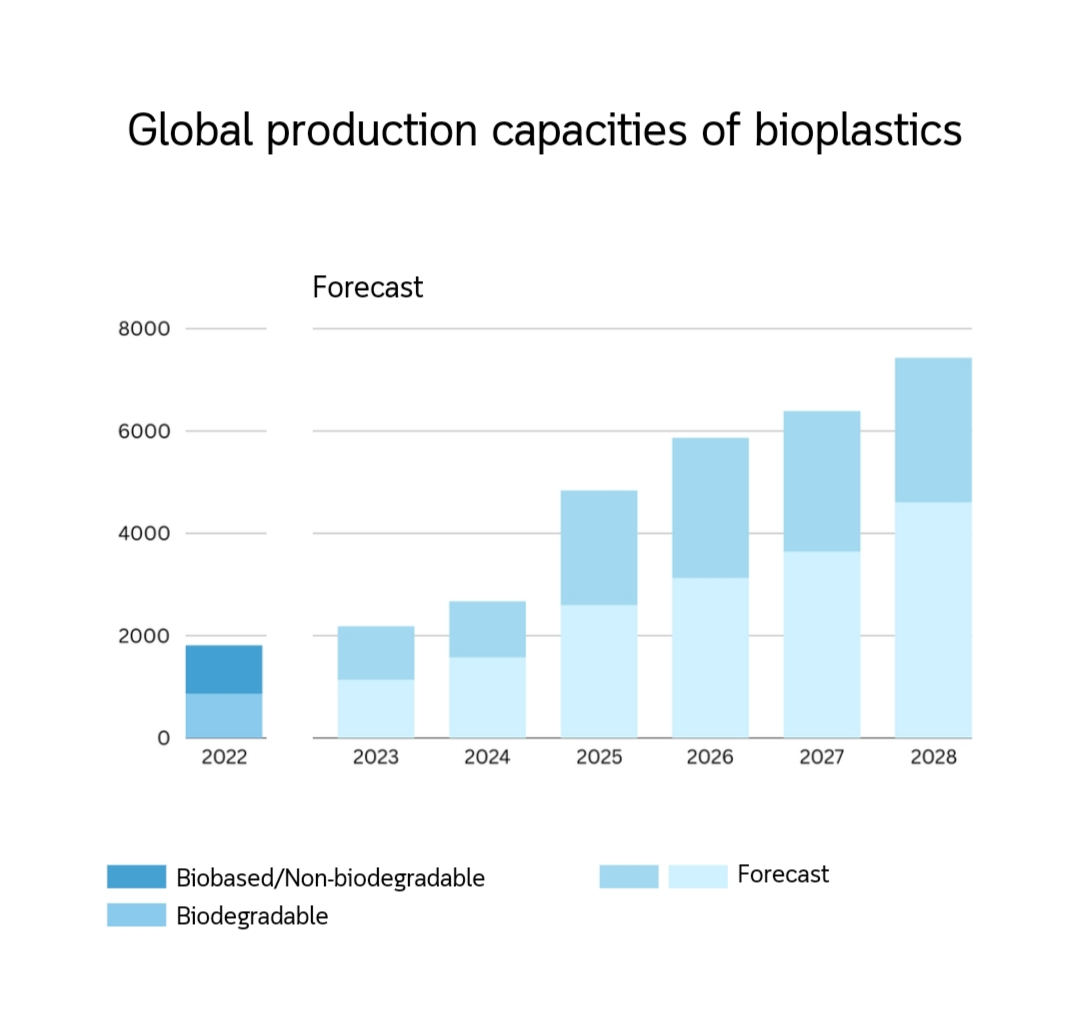
The chart above shows the projected growth of bioplastics production capacities, highlighting the increasing adoption of biodegradable plastics.
Bioplastics are increasingly used in different applications, from packaging and consumer products to electronics, automotive, and textiles, with packaging being the largest market segment.
3 - Mushroom Packaging
Mushroom packaging, also known as mycelium-based packaging, is a sustainable and biodegradable alternative to traditional packaging materials. Made from the root structure of mushrooms (mycelium), this material offers numerous environmental benefits and practical applications.
Mycelium packaging can be molded into various shapes and forms to fit different products. It has excellent cushioning and protective packaging, offering superior protection during transit.
Despite being lightweight, mycelium materials are strong and durable in protecting fragile goods. Their lightweight nature also reduces shipping costs and energy consumption.
After use, mycelium-based products break down without leaving toxic residues, mitigating long-term pollution.
The image below details the process: starting with CAD design and CNC milling, followed by forming growth trays filled with hemp and mycelium.
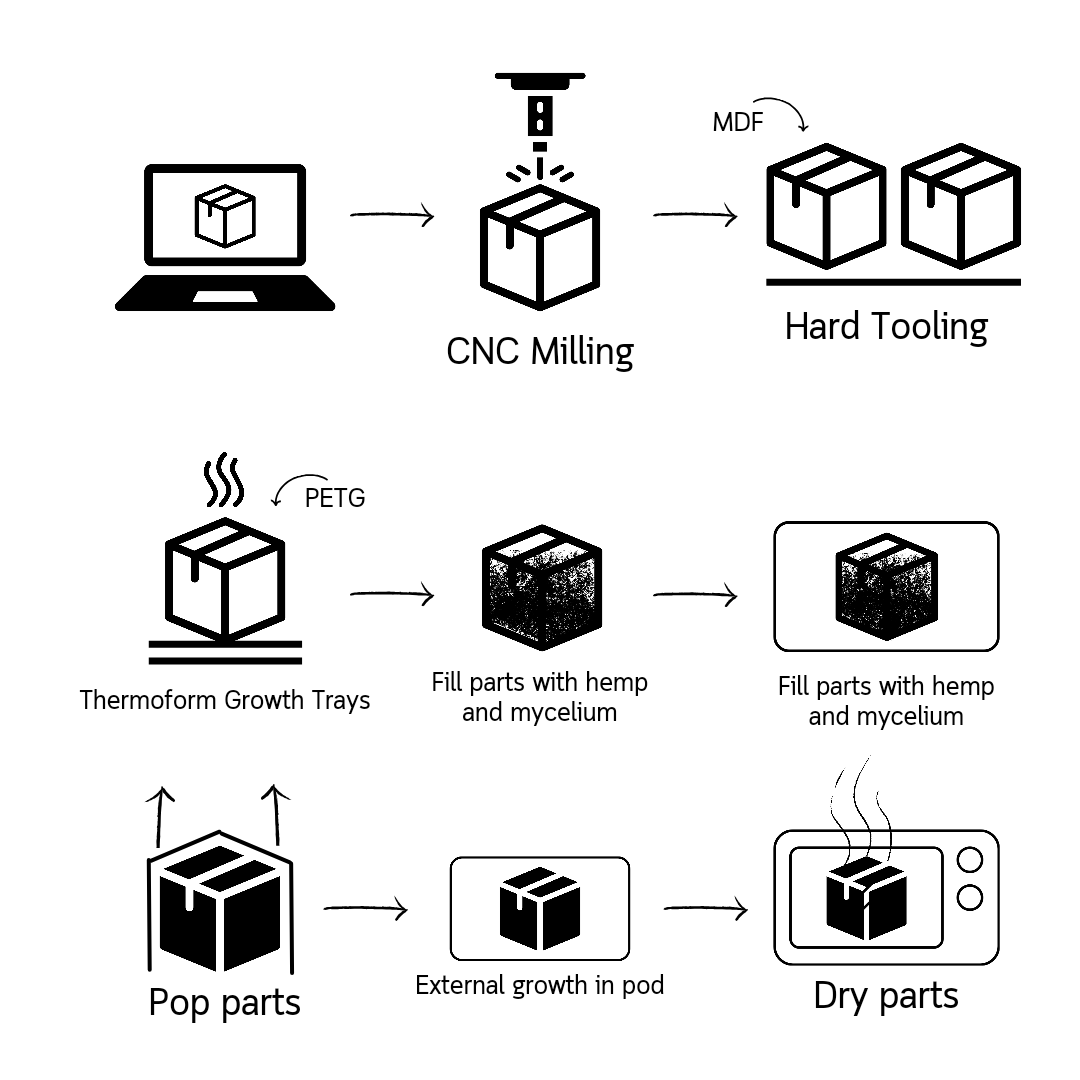
The internal growth occurs in pods, followed by external growth, and finally, the parts are dried to produce the finished product.
Prominent companies like Swedish furniture giant IKEA and computer manufacturer Dell have embraced mycelium packaging to reduce environmental impact.
Additionally, UK-based non-alcoholic spirit maker Seedlip is adopting mycelium packaging, highlighting its increasing acceptance and versatility across various industries.
4 - Bamboo Packaging
Bamboo packaging offers a versatile, sustainable, and aesthetically pleasing alternative to traditional packaging materials.
Indonesia, as the world's third-largest bamboo exporter, holds immense potential for developing a sustainable bamboo industry. The country is home to 176 of the 1,620 bamboo species found globally.
Although bamboo typically grows wild, only 25,000 out of 1 million hectares are cultivated in gardens and forests. The diverse range of bamboo packaging options provides consumers with multiple choices for both commercial and personal use.
Below is a table for the different packaging products made of bamboo:
| Product Type | Popular Uses |
| Food Containers | Lunch boxes, takeout containers, food storage jars |
| Cutlery and Utensils | Forks, spoons, knives, chopsticks, stirring sticks |
| Gift Boxes | Boxes for jewelry, luxury items, corporate gifts |
| Cosmetic Containers | Cream jars, lotion bottles, makeup containers, lip balm tubes |
| Bottleholders and Carriers | Wine bottle carriers, water bottle holders, beverage carriers |
| Packaging Tubes | Containers for cosmetics, spices, small gifts |
| Straws | Standard-sized straws, smoothie straws |
| Paper and Wrapping | Wrapping paper, tissue paper, paper bags |
| Pallets and Crates | Shipping pallets, crates, storage boxes |
These items are reusable, feature unique and intriguing designs, are most often free from chemicals, and offer excellent air circulation.
Supporting this effort fosters sustainable consumption and production, driving economic growth and environmental sustainability.
5 - Aluminum Packaging
Aluminum packaging is an excellent choice for eco-friendly packaging due to its durability, reusability, and recyclability.
One of the standout features of aluminum packaging is its ability to be recycled repeatedly without losing its inherent properties, a process known as real recycling.
This makes any form of metal packaging highly sustainable. For instance, up to 75% of all metal produced is still being used today, highlighting its longevity and recyclability.
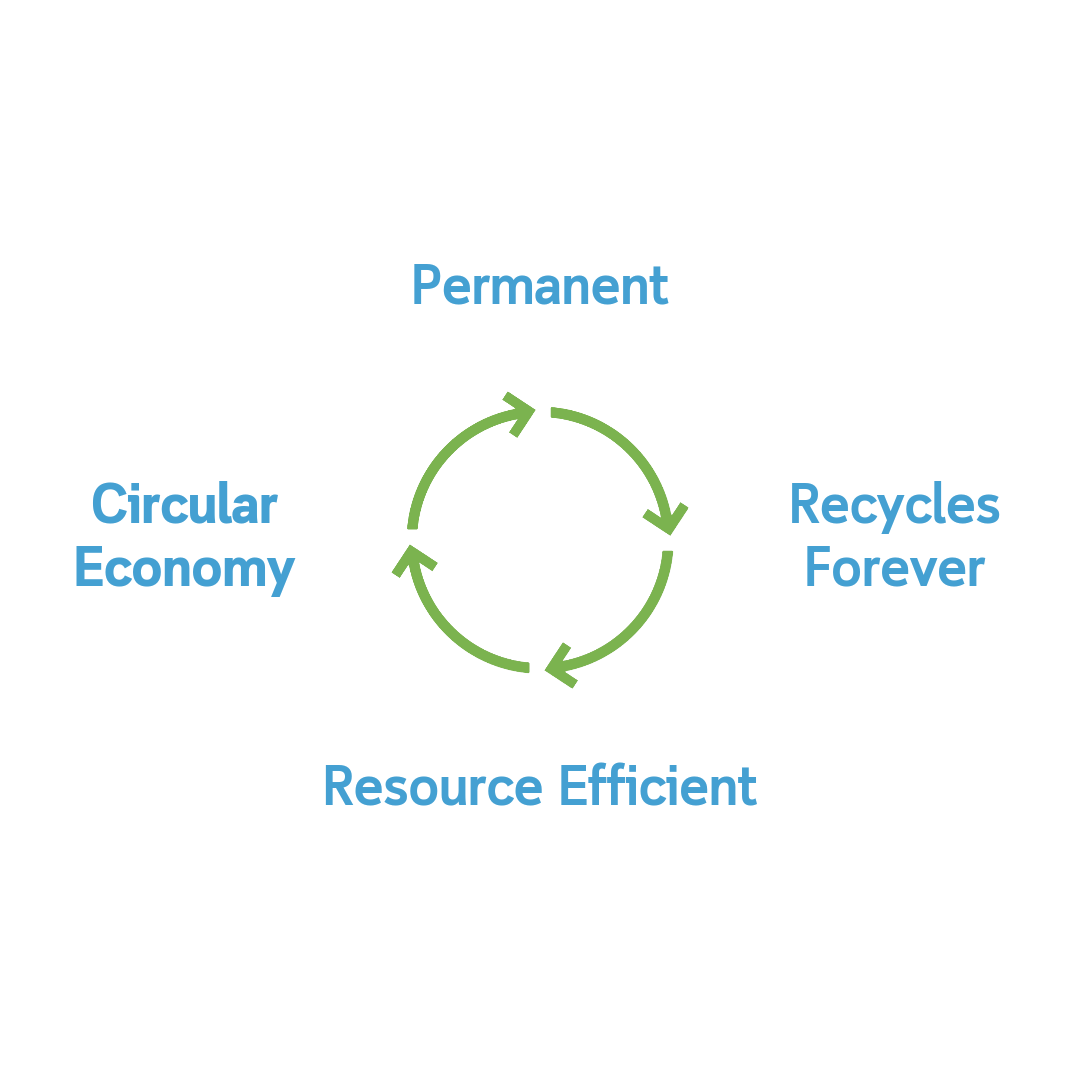
In Europe, the industry aims to achieve an average recycling rate of 80% by 2025. Currently, 78.5% of steel packaging and 76% of aluminum beverage cans are already being recycled, making metal packaging one of the most recycled forms.
6 - Seaweed Packaging
Seaweed packaging is an innovative and sustainable packaging solution derived from marine algae. This biodegradable and compostable material offers numerous benefits, including:
- Renewability: Seaweed is a fast-growing resource, making it a highly renewable raw material.
- Biodegradability: Unlike traditional plastics, seaweed packaging breaks down naturally, reducing landfill waste and environmental pollution.
- Non-Toxic: Seaweed packaging is free from harmful chemicals, ensuring it is safe for the environment and human health.
Seaweed packaging showcases its versatility across various applications. From keeping sandwiches, snacks, and other food items fresh with plastic-free wraps to edible films ideal for candies and sauces, seaweed offers a sustainable solution. It can even be processed into compostable container liners, ensuring product freshness and integrity.
Seaweed-based Biopac Indonesia has developed Biopac, a solution utilizing seaweed-based bioplastics to combat climate change and plastic waste. This approach reduces CO2 emissions and supports coastal communities by providing sustainable livelihoods through seaweed farming.
According to UNCTAD, the global seaweed market, valued at $17 billion, has significant potential for new applications, such as biostimulants and biodegradable plastics, projecting substantial market growth by 2030.
Most seaweed is currently used for food, aquaculture feed, or hydrocolloids. However, it also holds the potential for replacing fossil fuels, providing ecosystem services, and boosting socioeconomic benefits in coastal areas.
Case Studies of Successful Transitions to Eco-Friendly Packaging
In recent years, many businesses have transitioned to eco-friendly packaging, to reduce environmental impact and enhance their brand image.
Companies are adopting innovative solutions that minimize waste and pollution and resonate positively with environmentally conscious consumers. Here are the case studies of leading companies embracing eco-friendly packaging.
McDonald’s Environmental Strategy
McDonald's has made substantial efforts to reduce the weight and volume of its packaging materials. For example, the packaging for a typical meal in the 1970s required 46 grams, whereas today it requires only 25 grams, a 46% reduction.
Various specific reductions were achieved, such as reducing the weight of cold cups, breakfast lids, napkins, and the density of foam containers. Switching to bulk containers for products like orange juice and Coca-Cola syrup, significantly reduced packaging waste.
A commitment to spend $100 million annually on recycled materials, especially in restaurant construction and renovation. In 1991, they exceeded this goal, purchasing more than $200 million of recycled materials.
Nike’s Environmental, Social, and Governance
Nike, Inc., established in 1964, has evolved into a global leader in sportswear and athletic footwear. With increasing societal expectations for responsible business practices, Nike has integrated environmental consciousness into its operations.
Nike’s commitment to sustainability is exemplified by its innovative products, such as the Nike Air VaporMax. This product leverages a circular economy model through the Reuse-A-Shoe program, where used shoes are returned and repurposed to create new ones.
The Flyknit technology, utilized in the VaporMax models, significantly reduces material waste by using a single-piece upper construction, which aligns with Nike’s sustainability goals by minimizing resource consumption and incorporating recycled and eco-friendly materials.
Kellogg's Commitment to Sustainable Packaging Practices
Kellogg's has demonstrated a longstanding commitment to environmental sustainability, particularly in packaging. This dedication is reflected in their historical and current practices aimed at minimizing environmental impact through eco-friendly packaging alternatives.
Since 1906, Kellogg's has shown a pioneering spirit in sustainability by using 100% recycled cartons for the first box of Kellogg’s Corn Flakes.
Kellogg's continues to prioritize recycling, with 70% of their cardboard packaging made from recycled materials.
This practice reduces the demand for virgin paper, conserves resources, and decreases greenhouse gas emissions associated with the production of new cardboard.
Today, Kellogg’s ensures that all timber-based packaging materials used in Europe are sourced from sustainable sources. This means that the timber is harvested in a way that maintains the health and biodiversity of forest ecosystems.
These examples show that businesses of all sizes and industries can switch to eco-friendly packaging by starting small, making continuous improvements, and staying committed to sustainability goals.
Transitioning to Eco-Friendly Packaging
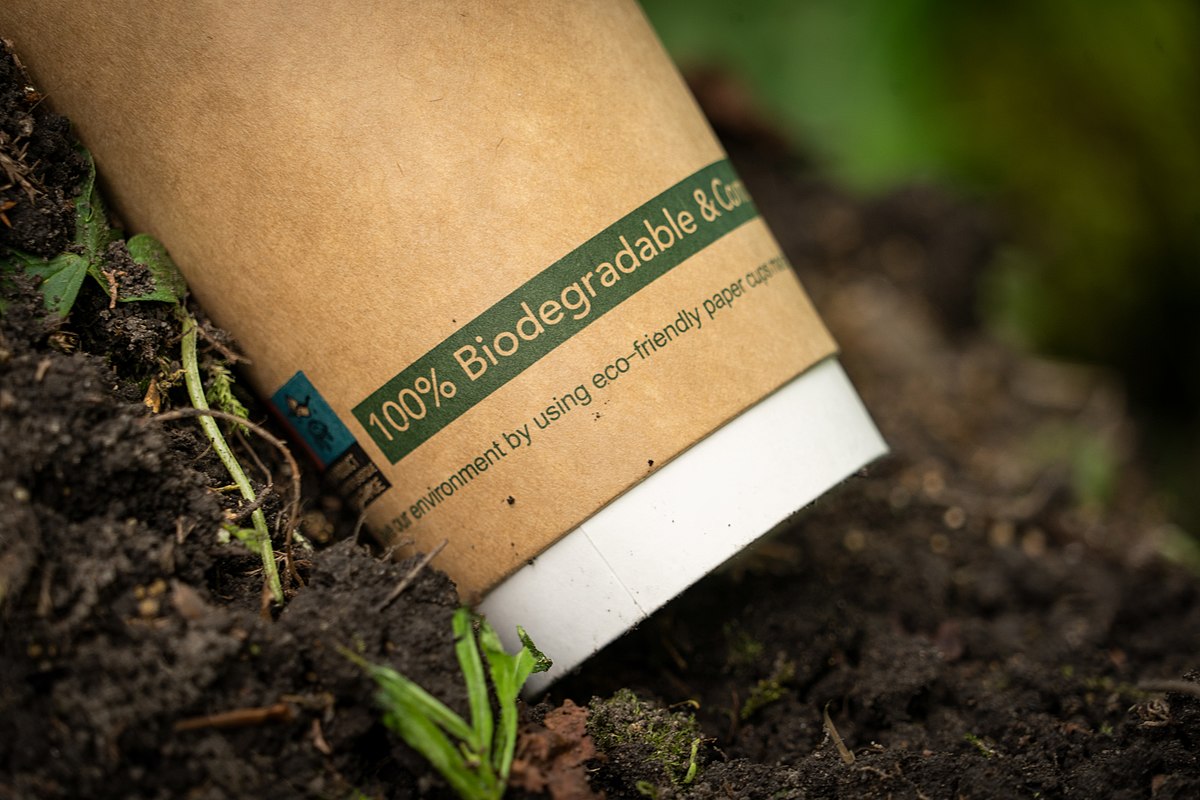
Transitioning to eco-friendly packaging requires careful planning and strategic implementation.
This section provides a step-by-step guide, tips for overcoming common challenges, and resources to assist in the transition.
Step 1 - Conduct a Packaging Audit
Assess your current packaging materials, usage volume, and disposal methods to identify areas for improvement and establish a baseline for measuring progress.
Step 2 - Research Eco-Friendly Alternatives
Explore materials such as recycled cardboard, biodegradable plastics, and plant-based packaging. Evaluate their environmental impact, cost, and functionality to determine the best fit for your products.
Step 3 - Engage Stakeholders
Involve employees, suppliers, and customers in the transition process. Conduct training sessions, launch communication campaigns, and establish feedback mechanisms to ensure everyone is on board.
Step 4 - Pilot Test
Implement a trial run with the new packaging for a specific product line or in a particular region. Use this test to gather insights, address potential issues, and make necessary adjustments.
Step 5 - Implement Gradually
Roll out the new packaging in phases to minimize disruption. Gradually replace old packaging with eco-friendly alternatives, allowing time to address any challenges that arise.
Step 6 - Monitor and Adjust
Track key metrics such as waste reduction, customer feedback, and cost implications. Continuously refine your approach based on these insights to ensure the transition's success.
Tips for Overcoming Common Challenges
Transitioning to eco-friendly packaging can present various obstacles. Here are practical tips to help you navigate and overcome common challenges, ensuring a smoother and more effective implementation.
Cost Management
Start with high-impact areas where the transition can yield significant environmental benefits and cost savings. Scale up gradually as efficiencies are gained.
Supply Chain Coordination
Collaborate closely with suppliers to ensure a steady supply of eco-friendly materials and negotiate bulk purchasing agreements to reduce costs.
Customer Communication
Communicate the benefits of the new packaging to your customers. Highlight your commitment to sustainability through marketing materials and product labels to enhance brand perception.
Regulatory Compliance
Stay informed about environmental regulations and ensure your packaging meets all necessary standards. This can prevent potential fines and enhance your business's reputation.
Resources and Tools
Accessing the right resources and tools is important for a successful transition to eco-friendly packaging. Below are essential aids to guide and support your business in adopting sustainable packaging practices.
Sustainability Consultants
Engage with experts who can provide tailored advice and best practices for your industry and packaging needs.
Industry Associations
Join organizations focused on sustainable packaging to access the latest research, case studies, and networking opportunities.
Certification Programs
Obtain certifications such as FSC (Forest Stewardship Council) or Cradle to Cradle to validate your commitment to eco-friendly practices and build trust with your consumers.
Software Solutions
Utilize tools and platforms to help businesses track and manage their sustainability efforts, such as life cycle assessment software and carbon footprint calculators.
By following this comprehensive guide and leveraging available resources, businesses can successfully transition to eco-friendly packaging, driving sustainability while meeting consumer expectations and regulatory requirements.
Frequently Asked Questions
How can businesses ensure the durability and functionality of eco-friendly packaging for products that require high protection?
Businesses can ensure durability and functionality by selecting advanced eco-friendly materials such as molded pulp, which provides excellent cushioning and protection; biodegradable polymers like PLA (Polylactic Acid), which offer similar properties to conventional plastics; and multilayered compostable films that combine strength and barrier properties.
Conducting thorough testing and collaborating with packaging experts can help tailor solutions to specific product needs.
Are there eco-friendly packaging options suitable for temperature-sensitive products, such as food or pharmaceuticals?
Yes, there are eco-friendly packaging solutions designed for temperature-sensitive products. Examples include insulated packaging from recycled denim or wool, which provides excellent thermal insulation; compostable coolers made from materials like mycelium or plant fibers; and bio-based phase change materials (PCMs) that maintain temperature stability.
These alternatives ensure product integrity while minimizing environmental impact.
How can companies measure the environmental impact of their packaging choices to ensure they are making the most sustainable decisions?
Companies can measure the environmental impact of their packaging through life cycle assessments (LCAs), which evaluate the environmental effects of packaging materials from production to disposal.
Tools like carbon footprint calculators, water usage assessments, and waste reduction metrics help quantify the sustainability of different packaging options.
Additionally, third-party certifications and eco-labels, such as Cradle to Cradle or the Environmental Product Declaration (EPD), provide verified information on the environmental performance of packaging materials.
What role does consumer education play in the success of eco-friendly packaging initiatives?
Consumer education is crucial for the success of eco-friendly packaging initiatives. Educational campaigns, clear labeling, and providing information on packaging materials' environmental impact can foster a culture of sustainability and encourage consumers to support eco-friendly products.
How do regulatory frameworks impact the adoption of eco-friendly packaging by businesses?
Regulatory frameworks play a significant role in the adoption of eco-friendly packaging. Governments worldwide are implementing stricter environmental regulations and incentives to promote sustainable packaging.
These regulations can include bans on single-use plastics, mandates for recyclable or compostable materials, and tax incentives for businesses adopting green practices.
Conclusion
In conclusion, eco-friendly packaging presents a viable and beneficial alternative for businesses seeking to reduce their environmental impact, enhance their brand image, and meet their sustainability goals.
While the initial investment may be higher than traditional packaging, the long-term benefits, including potential cost savings and customer loyalty, can outweigh the costs. Transitioning to eco-friendly packaging requires careful planning and execution to minimize disruption to operations.
As the demand for sustainable practices continues to grow, staying informed about developments in eco-friendly packaging is crucial for businesses aiming to stay competitive and responsible in the market.
Resources
(n.d.). Wikipedia. Retrieved June 5, 2024, from https://youtu.be/xjjLpFQSHUA
(n.d.). Wikipedia, the free encyclopedia. Retrieved June 5, 2024, from https://igcat.org/eat-your-food-and-the-package-too/
(n.d.). Wikipedia. Retrieved June 5, 2024, from https://www.epa.gov/facts-and-figures-about-materials-waste-and-recycling/paper-and-paperboard-material-specific-data
(n.d.). The Ting Xu Group. Retrieved June 5, 2024, from https://xugroup.berkeley.edu/
(n.d.). Wikipedia. Retrieved June 5, 2024, from https://www.southampton.ac.uk/news/2020/11/drink-bottles-environmental-impact.page
(n.d.). Wikipedia. Retrieved June 5, 2024, from https://stories.undp.org/why-arent-we-recycling-more-plastic
(n.d.). Wikipedia. Retrieved June 5, 2024, from https://openknowledge.worldbank.org/entities/publication/4ac8c40c-cc4d-4f38-90a9-01b7bbaad3eb
(n.d.). Wikipedia. Retrieved June 5, 2024, from https://youtu.be/csUkAiwWXYU?si=lflERFMcnLpJgk0G
(n.d.). Wikipedia. Retrieved June 5, 2024, from https://blogs.rochester.edu/thegreendandelion/2019/04/recycle-your-sneakers-with-nike-reuse-a-shoe/
(n.d.). Wikipedia. Retrieved June 5, 2024, from https://youtu.be/0WYNI5X9cWY?si=KKRFPSwKjuGLN8Fg
(n.d.). Wikipedia. Retrieved June 5, 2024, from https://www.fdf.org.uk/globalassets/resources/case-studies/ambition-2025/ambition-2025-kelloggs-2-2019-fdf-case-study-template.pdf
(n.d.). Wikipedia. Retrieved June 5, 2024, from https://youtu.be/JpWb_3lk_mE?si=za9zecqzgmEOOnoF
(n.d.). Wikipedia. Retrieved June 5, 2024, from https://fsc.org/en
(n.d.). Cradle to Cradle Products Innovation Institute: Home. Retrieved June 5, 2024, from https://c2ccertified.org/
(n.d.). Wikipedia. Retrieved June 5, 2024, from https://www.osti.gov/biblio/1963849
(2024, May 6). Recommendation Analysis. Retrieved June 5, 2024, from https://writing.utah.edu/_resources/documents/2024/awards-papers/jacqueline-huynh-paper.pdf
Angelova, G. V. (n.d.). Mushroom Mycelium-Based Biodegradable Packaging Material: A Promising Sustainable Solution for the Food Industry. E3S Web of Conferences. Retrieved June 5, 2024, from https://www.e3s-conferences.org/articles/e3sconf/pdf/2023/63/e3sconf_icobar23_02128.pdf
Bamboo's Benefits For Eco-Friendly Packaging - Green Info. (2022, May 19). Greeneration Foundation. Retrieved June 5, 2024, from https://greeneration.org/en/publication/green-info/bamboos-benefits-for-eco-friendly-packaging/
Biopac: Seaweed-based packaging to deliver climate solutions for land and marine ecosystems. (n.d.). MIT Solve. Retrieved June 5, 2024, from https://solve.mit.edu/challenges/2024-global-climate-challenge/solutions/87660
Case A: McDonald's. (n.d.). World Resources Report. Retrieved June 5, 2024, from http://pdf.wri.org/bcs_mcdonalds_casea.pdf
Compostable Packaging Materials Made From Mushrooms — Innovation — AskNature. (n.d.). AskNature. Retrieved June 5, 2024, from https://asknature.org/innovation/compostable-packaging-materials-made-from-mushrooms/
Environmental Impact of Food Packaging Materials: A Review of Contemporary Development from Conventional Plastics to Polylactic Acid Based Materials. (2020, November 6). NCBI. Retrieved June 5, 2024, from https://www.ncbi.nlm.nih.gov/pmc/articles/PMC7664184/
Environmental Product Declarations (EPDs) - GSA Sustainable Facilities Tool. (n.d.). Sustainable Facilities Tool. Retrieved June 5, 2024, from https://sftool.gov/plan/402/environmental-product-declarations-epds
5 sustainable alternatives with use of Mushrooms Mycelium | World Economic Forum. (2020, December 4). The World Economic Forum. Retrieved June 5, 2024, from https://www.weforum.org/agenda/2020/12/mycelium-mushroom-sustainable-packaging-fashion-meat/
Ikea is Switching to Biodegradable Packaging Made From Mushrooms. (n.d.). Global Citizen. Retrieved June 5, 2024, from https://www.globalcitizen.org/fr/content/mushroom-fungi-packaging-ikea-decompose-ecovative/
Keeping Glass Recycling Financially Sustainable: A Cost - Benefit Analysis. (2017, December 15). ScholarWorks@BGSU. Retrieved June 5, 2024, from https://scholarworks.bgsu.edu/cgi/viewcontent.cgi?article=1398&context=honorsprojects
Market – European Bioplastics e.V. (2024, January 30). European Bioplastics. Retrieved June 5, 2024, from https://www.european-bioplastics.org/market/
An Ocean of Opportunities: The Potential of Seaweed. (2024, March 20). unctad. Retrieved June 5, 2024, from https://unctad.org/system/files/official-document/ditcted2024d1_en.pdf
Paper Packaging | AF&PA. (n.d.). American Forest and Paper Association. Retrieved June 5, 2024, from https://www.afandpa.org/paper-wood-products/packaging
Pengembangan Bambu Berkelanjutan. (2021, May 4). Kementerian Koordinator Bidang Perekonomian. Retrieved June 5, 2024, from https://www.ekon.go.id/publikasi/detail/2966/pengembangan-bambu-berkelanjutan
A Perspective on Polylactic Acid-Based Polymers Use for Nanoparticles Synthesis and Applications. (2019, September 26). Frontiers. Retrieved June 5, 2024, from https://www.frontiersin.org/articles/10.3389/fbioe.2019.00259/full
Sanders, R. (2021, April 21). New process makes 'biodegradable' plastics truly compostable - Berkeley News. Berkeley News. Retrieved June 5, 2024, from https://news.berkeley.edu/2021/04/21/new-process-makes-biodegradable-plastics-truly-compostable/
Sustainability. (n.d.). Metal Packaging Europe. Retrieved June 5, 2024, from https://www.metalpackagingeurope.org/sustainability
Sustainability – Recycling | Aluminum Association. (n.d.). The Aluminum Association. Retrieved June 5, 2024, from https://www.aluminum.org/Recycling
Visual Feature | Beat Plastic Pollution. (n.d.). UNEP. Retrieved June 5, 2024, from https://www.unep.org/interactives/beat-plastic-pollution/
What is life cycle assessment (LCA)? | Golisano Institute for Sustainability | RIT. (2020, July 2). Rochester Institute of Technology. Retrieved June 5, 2024, from https://www.rit.edu/sustainabilityinstitute/blog/what-life-cycle-assessment-lca
Why choose Glass? (n.d.). FEVE. Retrieved June 5, 2024, from https://feve.org/about-glass/



